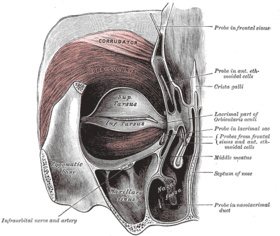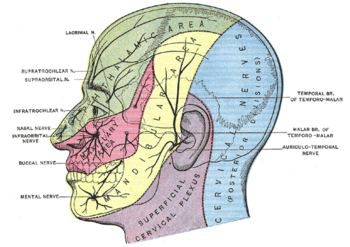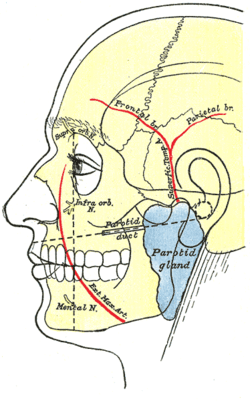Infraorbital nerve
| Infraorbital nerve | |
|---|---|
 Left orbicularis oculi, seen from behind. (Infraorbital nerve labeled at lower left.) | |
 Sensory areas of the head, showing the general distribution of the three divisions of the fifth nerve. (Infraorbital nerve labeled at center left, at the nose.) | |
| Details | |
| From | maxillary nerve |
| Identifiers | |
| Latin | Nervus infraorbitalis |
| TA | A14.2.01.059 |
| FMA | 52978 |
After the maxillary nerve enters the infraorbital canal, the nerve is frequently called the infraorbital nerve. This nerve innervates (sensory) the lower eyelid, upper lip, and part of the nasal vestibule and exits the infraorbital foramen of the maxilla. There is a cross innervation of this nerve on the other side of jaw.
Clinical relevance
The infraorbital nerve block is a type of local anesthetic nerve block used to induce analgesia in the distribution of the nerve for whatever purpose.
After a fracture of the floor of the orbit, the infraorbital nerve may become trapped, producing an area of anaesthesia under the orbital rim.
See also
Additional images
 Mandibular division of the trigeminal nerve.
Mandibular division of the trigeminal nerve. The nerves of the scalp, face, and side of neck.
The nerves of the scalp, face, and side of neck. Outline of side of face, showing chief surface markings.
Outline of side of face, showing chief surface markings. An illustration of the path of the maxillary nerve.
An illustration of the path of the maxillary nerve.- Infaorbital and buccal nerve.Superficial dissection.Lateral view.
References
This article incorporates text in the public domain from the 20th edition of Gray's Anatomy (1918)
External links
- Anatomy photo:33:08-0104 at the SUNY Downstate Medical Center
- lesson3 at The Anatomy Lesson by Wesley Norman (Georgetown University)
- MedEd at Loyola GrossAnatomy/h_n/cn/cn1/cnb2.htm
- lesson3 at The Anatomy Lesson by Wesley Norman (Georgetown University) (orbit6)
This article is issued from Wikipedia - version of the 8/18/2016. The text is available under the Creative Commons Attribution/Share Alike but additional terms may apply for the media files.